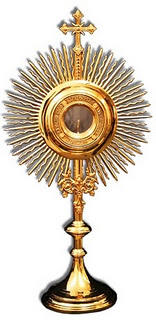
Mass
Catholicism
Religion
[2011] Solving the Mystery of Babylon the Great by Edward Hendrie The monasticism and the religious services of Lamaism also present so striking a similarity with Catholic institutions that non-Catholic investigators have unhesitatingly spoken of a "Buddhist Catholicism" in Tibet. Pope and dalai-lama, Rome and the city of Lhasa are counterparts; Lamaism has its monasteries, bells, processions, litanies, relics, images of saints, holy water, Rosary-beads, bishop's Mitre, crosier, vestments, copes, baptism, confession, mass, sacrifice for the dead
Paganism and Catholicism: Mass

In the Roman Catholic mass, the Eucharist or “host” (the round wafer) is a symbol of the sun. It is normally placed during ceremonial masses on a monstrance with a crescent moon, symbolizing the plunging of the sun into the womb of the goddess. Some monstrances bear the letters “SFS,” which represents 666, as S was the sixth letter in the ancient Greek alphabet and F is the sixth letter in our alphabet.
The round disc in the crescent moon was a symbol of ancient Babylon, and is found in all the ancient religions. In Catholic cathedrals, these symbols are very prominent, often depicting a round form of mother and child within the crescent moon.
The rebirth of the sun god was celebrated by the eating of round bread in Babylonian times, and was common in Mithraism and Osiris worship. Historian Alexander Hislop says this:
And here, in a so-called Christian Church, a brilliant plate of silver, “in the form of the SUN,” is so placed on the altar, that everyone who adores at the altar must bow in lowly reverence before that image of the “SUN.” Whence, I ask, could that have come, than from the ancient SUN-worship, or the worship of Baal? And when the wafer is placed so that the silver “SUN” is fronting the “round” wafer, whose "roundness" is so important an element in the Romish Mystery, is only another symbol of Baal, or the sun, what can be the meaning of it, but to show to those who have eyes to see that the “Wafer” itself is only another symbol of Baal.i
Pope John Paul wrote in 1998 that mass also includes an element of Mary veneration, which, as we have seen, is also a pagan practice:
Significantly, the Catechism of the Catholic Church teaches that "the Sunday celebration of the Lord's Day and his Eucharist is at the heart of the Church's life"…As they listen to the word proclaimed in the Sunday assembly, the faithful look to the Virgin Mary, learning from her to keep it and ponder it in their hearts (cf. Lk 2:19). With Mary, they learn to stand at the foot of the Cross, offering to the Father the sacrifice of Christ and joining to it the offering of their own lives. With Mary, they experience the joy of the Resurrection, making their own the words of the Magnificat which extol the inexhaustible gift of divine mercy in the inexorable flow of time: "His mercy is from age to age upon those who fear him" (Lk 1:50). From Sunday to Sunday, the pilgrim people follow in the footsteps of Mary, and her maternal intercession gives special power and fervour to the prayer which rises from the Church to the Most Holy Trinity.ii